Price, funding, revenue, development costs... these are not terms traditionally associated with roguelikes. The situation has changed significantly over the past several years, though. Not only are there many more roguelikes these days, but some of them (*gasp*) even cost real money!
Having made the leap from years of hobbydev to years of commercial roguelikedev, I have some thoughts and experiences to share on the somewhat contentious idea of raising money for a roguelike, and pricing strategies in general. Although I write in terms of roguelikes, most of the same principles can be applied to other genres as well.
In short, Cogmind's approach to pricing has worked out perfectly, initially meeting my expectations, and then before long exceeded them. Repeatedly.
Why Pay for a Roguelike?
Before I get into examples, the short answer is that money makes more things possible. Who doesn't want even more higher quality games from their favorite genre?
As for specifically what money can do for roguelikes, not too long ago on the Cataclysm: Dark Days Ahead forum a relevant thread popped up.
You see this a lot in roguelike development, where accessibility and UI features are an afterthought. That's not to say they aren't important, nor would many developers make such a claim, but it is widely considered a less enjoyable part of creating a roguelike. Roguelikes are all about adding new mechanics and content--heck, rapid feature development is one of ASCII's strong suits to begin with! UI work requires yet more time (on top of all the other things RL dev entails) in a very different area of expertise.
Kevin (C:DDA developer) at the end there makes the point well: Hobby projects are more about what the dev wants to do. I can say from experience that after having switched from hobby to commercial development, the focus shifts towards a lot of what the dev should/must do. Sure there's still the fun stuff--the new mechanics, new map generators, finding new and exciting ways to killchallenge players... but I also spend plenty of time doing things I don't necessarily feel like doing.
You know, like most any other job that pays :P
A developer charging money for a game has an obligation to serve the player wherever possible, and that means devoting proper attention and resources to usability. Note that this in no way implies sacrificing creative control, it just means treating the project as a proper business--taking feedback, interacting with players (who double as customers), and providing customer service. As such, accessibility features have a much higher priority for me, which a lot of players appreciate.
Players get so much more than that, though. Increased production value and quality make up the bulk of obvious benefits from paid roguelikes. Being able to invest extra time or money means:
- Extensive professional tilesets of a consistent quality and style. ADOM currently has over 6,000 tiles; ToME4 has a mind-boggling total north of 20,000; Caves of Qud has upwards of 5,000; Cogmind has 1,165 (plus over a hundred custom font bitmaps, a thousand pieces of ASCII art, and many hundreds of procedural animations). And because they're all in development, these totals are still increasing as time goes by! (It's early yet for DoomRL successor Jupiter Hell, but with all those 3D assets it's in a league of its own and certainly not happening without funding! (already acquired through KS))
- Sound effects aren't something that a lot of roguelikes do--that's mostly roguelite territory, but Cogmind has made it a big part of the experience with over a thousand samples and counting (far more than any other roguelike and most other indie games).
- Music. Some roguelikes do this, too! (Still to write: my own article on that topic.)
Certainly plenty of perfectly good roguelikes have none of these things, but many of the more widely popular ones do, not to mention the potentially long stretches with no fixes for bugs reported in non-commercial roguelikes.
Optional elements aside, considering the time-intensive nature of roguelike development, simply having more time to dedicate to new features is a big thing. A revenue stream enables continuous development, much more desirable than the sporadic updates endemic to hobbyist gamedev (for which the ARRP was a somewhat successful attempt to remedy, but still can't compare to directly funding the process!).
Development on Ultima Ratio Regum, an amazing free roguelike project started in 2011 but only about half done by now, was unexpectedly halted for some months shortly before a planned release last year. Mark is now back at it again, but a number of other roguelikes have died or faded out over the years before reaching completion. Pure hobby projects tend to progress more slowly, and therefore stand a greater and greater chance of dying as time goes on. It's just a fact of life, in which any number of causes can spell the end of (or at least interrupt) development, be it family, studies, work, a change of interests, or "a bigger better idea!!1" :). From that perspective, means to accelerate progress are a good thing (and of course for their part players won't complain about access to more timely updates!).
Honestly it's a huge amount of pressure to keep up that near-nonstop progress, but the ability to (relatively speaking) quickly and efficiently put together a world that others can enjoy is worth it.
As an experiment, let's look at the hours I've put into Cogmind as of this writing (6,623) in a different light: What if this were a hobby project done in my spare time? Excluding basic needs and all other responsibilities, based on years of data I generally have about 50 hours to spare each week for work (all of which currently goes towards Cogmind). Assuming I use up 40 of that for a different job and develop purely as a hobby instead, and also making the big assumption that doing this other job wouldn't leave me even more exhausted and desiring extra time to relax and get away from brain-draining activities (it would), that leaves 10 hours per week... 6,623 h / 10 h/wk = 662.3 weeks, or 12.7 years!
So rather than Cogmind being what it is today in January 2017, having started as a hobby back at the original date of June 2013 it would not reach its current state until July 2025. Sure we could chop off a year or two because, yes, I might spend vacation time working as well (though we'd also have to cut out the occasional weeks where I'd be too busy with other life stuff)--anyway, it's a generalization, but no matter how you look at it that's still terribly slow.
Then of course there's the fact that it's not done yet :P. I can say for sure that including post-1.0 work it'll easily top 8,000 hours (beyond that I don't really know).
In the end, most roguelikes and features are technically possible without any funding whatsoever, but it's going to take a lot longer (which, again, increases the chance of failure), or a lot of manpower (DCSS is a good, if rare, example there).
Why $30? Balancing Price with Other Factors
Although as I write this alpha access is available for $25, in 2015 Cogmind was introduced at $30, the price at which it remained for the entire first year of public alpha. As you would expect, reactions to this number ran the entire spectrum from "for an alpha?!?!?" to "totally happy to pay that!"
I based the specific number on a couple data points, first and foremost what I'd noticed from video game Kickstarter campaigns, that early access as a "perk" often came with tiers upwards of $30. Even outside KS, I found games like RimWorld, similarly a highly-replayable game under long-term alpha development at a good pace by a very active dev, which priced its alpha access at $30.
Overall it felt like a plausible range was somewhere around $20-$30. I would definitely not claim this approach is good for maximizing revenue potential, or even maximizing players while still bringing in "sufficient" revenue, but that wasn't the goal!
Graph demonstrating the concept of elastic demand (source). Video game demand is pretty darned elastic!
It's fairly obvious that a lower price point might very well outsell the current sales model in terms of total revenue, but to me there are more important factors than money to consider in the short term. The point of alpha funding is to keep development humming along until 1.0, before which too many players actually becomes a problem!
While not necessarily true of all devs, I believe in the importance of being active in the community, responding to everyone with a concern, question, or some other need of support, while also putting effort into making resources, extensive progress updates, and other information available outside the game. This requires a significant time investment, the effects of which are even more pronounced as a lone developer where talking to players means I'm not making real progress on the game itself.
Lower prices naturally attract more players, which given this community-oriented model will inevitably slow development as more and more time is spent on community management. But I love having the opportunity to maintain closer relations with a smaller player base, even adding custom options at the request of a single player, while still having plenty of time to work on the next release. So in this regard a higher price is beneficial for both development and the ongoing alpha player experience.
Game development is also incredibly risky, so it's nice to use any knowns to mitigate elements of risk wherever possible. This, too, played a role in the original pricing decisions, which you can see below from my general thought process:
- I do know that I have an established fan base who would be willing to pay more for a quality roguelike with quality continuous development and support.
- I don't know whether lowering the price to something more common across the entire indie market (like <=$10) would be able to attract enough players to even make up the difference. But I do know that even if it could, having 2-3 times as many players would be a larger burden on the process and unnecessarily slow development. The resulting "high noise-to-signal ratio" also makes it harder to focus on the best design decisions.
- Niche games, especially those with something truly unique to offer, can afford to charge more, and in many cases must charge more in order to be at all sustainable. Long-term sustainability is quite important to me, since this isn't a one-off thing and I hope to not only develop it further beyond 1.0, but also work on other games as well. It's (hopefully) a permanent job.
In that light, a $30 price point seemed the much safer route.
From a purely economic standpoint, where time is not a limiting factor (i.e. development and support can and will continue for quite a while), setting a higher price is also just smart business. Eldiran over on /r/gamedev (where especially when starting out I read a lot of first-hand industry info that was very helpful) put it very well in response to a question about how discounts damage indie sales:
Different players value your game differently. Hardcore fans want to buy it as soon as possible at full price. Some genre fans might be willing to grab it once it hits 10-20% off. People who are only mildly interested might wait for a 50% sale. And so on.
If you set up a 50% sale early on, all of those groups will buy it for 50%. That means you lost all the extra money you could have gotten from the 10% group, the 30% group, etc.
There are lots of other considerations. Consider what it looks like as a buyer to see a game go 50% or 75% off shortly after release. That would look like the developer isn't confident in the quality of their game. Maybe they're just trying make a quick buck with manipulative sales, and the game sucks?
That said, there are situations where getting a big playerbase as fast as possible is more important, such as for multiplayer-only games. Then it might be worth it to do sales early and often.
The comment is in reference to sales, but the same principles apply to pre-release pricing as well.
It's not purely a numbers game, though--the price is still very much associated with potential value. Subjectively speaking, I consider Cogmind worth that price if I were a player looking at such a game, and clearly many others agree. Everyone else can make that call for themselves based on the large amounts of information available, while a higher price serves a useful secondary purpose here: prevent impulse buys. Impulse buys, which are where a lot of developers can expect to bring in more players via low prices and steep discounts, are also where a lot of the noise-to-signal problems mentioned earlier come from. It leads to too many distracting, non-constructive comments from players who probably haven't spent very long with the game in the first place. (Not to say first impressions aren't important, too, but they shouldn't make up the bulk of the discussion.)
Side note: A great tool for games with a higher alpha price is a one-time mailing list for those who wish to be notified when the game comes down to its regular price. Over 1,000 people have signed up for that already. This is essentially akin to the Steam wishlist, albeit without the Steam part :P
A pricing discussion wouldn't be complete without a look at the common argument for a lower price before full release: Players may very well be playing an unfinished, buggy version that's not necessarily all that much fun, where a higher price equates to paying a premium to help find and report bugs! (That sounds like work...) I completely agree with that argument, though I would also argue that developers need to try to release early versions that are not so buggy, and fun from the start. Then it suddenly becomes more of a privilege to join the alpha process, where those players are not only having fun, but can also influence the future direction of the game via their feedback.
This is how I handled Cogmind--sure there have been bugs, but a relatively tiny number, nor is it usually anything serious (most serious bugs are discovered via automated testing prior to updates, and those which aren't are patched immediately, generally within an hour of reporting). Fixing bugs is always a top priority, and even the original 7DRL is fun so that aspect is covered, hence the overall player consensus that "it doesn't feel like an alpha," which is exactly the kind of sentiment that is important to lay the foundation for by building a quality pre-alpha in the first place.
Yet another advantage of a higher alpha price is a factor many non-developers may not realize: while in early access and not on Steam I can devote a lot more of the revenue to actual development, whereas on Steam a majority of the funds would go to Valve (30% fee) and the US government (taxes...), and they're certainly not going to help make Cogmind better! :P So each individual person supporting my work at this stage has been far more valuable to the project than even a handful of supporters on Steam could be, and the results are amplified with a higher price, all while keeping the player base to a manageable size. (Clarification: Steam is definitely a valuable channel in the long term, as it provides access to a much larger pool of players--so many only buy through Steam!--but given the context it's not the right choice for me at this time. That said, in the interest of sustainability the amount of post-1.0 work will be mostly contingent on how successful Cogmind is on Steam.)
Getting Results
Cogmind Alpha Access has been quite successful, my definition being that it's been able to fund itself. And that's with just the right amount of feedback from players to help improve the design without causing too much of a drag on the process.
Revenue has been both relatively steady and just enough to keep development going. In fact, the process has been going so smoothly that the original plan to "finish" by the end of 2015 was quickly scrapped in favor of another year of developing extra features, which became yet another year of decent revenue that pushed the intended deadline into 2017. Sure, development could've been rushed to the planned 1.0 over a year ago, but there were/are so many tempting optional features, and many new players have come to support this project, so why not add more fun stuff? :D (For the curious, a sampling of the features so far that could only be added as a result of strong alpha support: traps, Trojans, Waste, garrisons, Zionite plot line, about 15% of the items, numerous additional robot designs, countless extra UI features, large-scale refinement of mechanics like hacking, machines, and flight...)
Since Cogmind was available at more than one price when alpha access began (an idea inherited from Kickstarter but without the temporary campaign nature), let's look at the reasoning and performance of each of the tiers.
- $90. While as a sum this highest tier seems expensive, it included multiple keys at essentially $22 each, or $15 if you subtract the value of the t-shirt thrown in. This whole tier was just something I wanted to do because having a custom t-shirt is neat, and 18 other people liked the idea, too :) (only available during the first month, though since then there have been numerous requests to bring back the t-shirt, so I've been taking names and will do that at some point).
- $60. I can't take credit for this idea, which turned out to be a really nice one indirectly suggested by sambojin over on the Bay 12 forums, who shortly before launch said he hoped for a way to buy more than one key, preferably at a discount, to give the others away. That sounded like a perfectly reasonable request, thus the Improved Tier was born and to this day 9.7% of all revenue falls into this tier. And it's not only for gifting, either, as multiple supporters can pool their money and buy this 3-pack which breaks down to $20 each. Especially soon after the launch period it was possible to see such groups forming on various forums among friends. There are multiple advantages here, including a bit of free marketing while also giving those who couldn't afford $30 a way to acquire it at a 33% discount. I also made sure to clearly indicate that $20 is the intended launch price for 1.0 (it always has been). Managing expectations is an important part of pricing!
- $30. This one was already covered pretty well. It accounts for 85.6% of revenue in the first year, before the next tier was introduced.
- $25. When the first anniversary of Alpha Access rolled around (May 2016), sales seemed to be in an ever-so-gradual decline, thus it was a perfect opportunity to introduce the first price drop. It was nice to have that middle-ground leeway in between what it was and the future launch price, enough to make a difference to buyers but still be a respectable amount of revenue without opening the flood gates to new players. As expected, sales picked up again, and have continued at a good pace ever since.
- $20? More recently I've taken to offering the occasional 20% discount coupon in coordination with other events. These are neat since I can see precisely how much a lower price stimulates real buying interest coming from various sources by using different coupon codes for each.
Note that even in introducing the $25 tier, I did not remove the $30 tier. It's still available as it offers a few perks that don't come with the new lowest tier, just a thank you in the credits and a forum badge. And despite the availability of $25 access, some people still go for $30! From May 19, 2016, to date, the $30 tier still accounted for 14.1% of individual sales (15.9% of revenue). Had the same group of people instead only had the $25 option, gross revenue would have simply been $795 less. Not providing ways for individuals to offer extra support when they have both the means and desire is so-called "leaving money on the table." And when I see that during alpha dev it means "leaving features on the table, too" :P
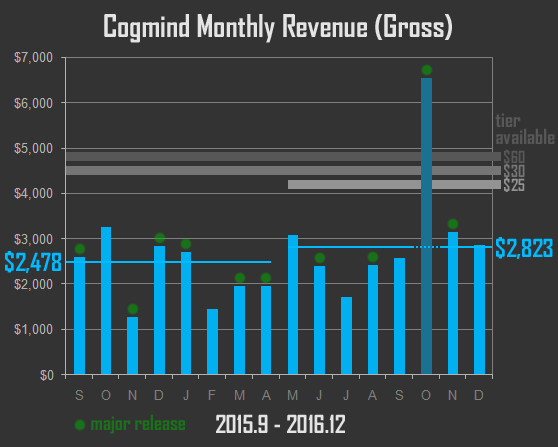
Cogmind Monthly Revenue (Gross), 2015.9 - 2016.12
(graph excludes initial 4-month period after first release due to distortion by outside factors)
While there are too many factors involved to draw sweeping conclusions, it's probably safe to say that lowering the price in May didn't hurt the bottom line. Compared to the period before, when the lowest price was $30, average monthly revenue rose 13.9% from $2,478 to to $2,823. The latter average excludes October, which was a weird month because it was Cogmind's largest-ever update combined with a little surprise article from RPS. In fact, October, November, and January were three consecutive "largest ever" releases (January's not quite done so I couldn't include that data, but it looks like it could break $4k alone).
Actually, we can do better than this with a comparison of averages from just the few months before and after May. February through April (plus the first half of May) sales were showing clear signs of flagging (monthly average: $1,927), while in the four and a half months after adding the new tier (through September, before things started getting crazier) the average increased 45.3% to $2,799. Looking at it that way, the change had a larger impact than I'd realized! A more detailed look at the difference between the 15 days before and after May 19th is equally telling:
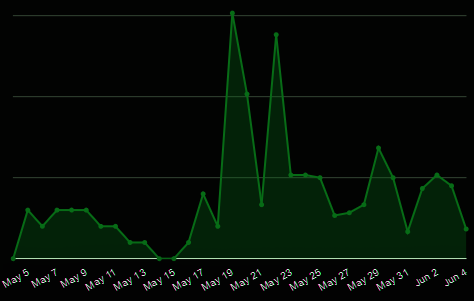
Cogmind Daily Revenue, May 5 - June 5 (2016)
During the months leading into early May I was getting kinda worried because I'd definitely have to wrap up development more quickly if that trend kept up (see those two zero days?! Scary!). But the new price put alpha back on a healthier long-term feature-filled schedule. The one-year anniversary turned out to be an excellent opportunity used well.
Changing Times
Indie devs in general tend to undervalue their games, though it's nice to see that a growing number of devs aren't afraid to charge a (minimally) decent price for paid roguelikes. Caves of Qud is only $9.99 for early access, but will reportedly rise to $14.99 at full release; both Ancient Domains of Mystery and Dungeonmans are $14.99; Jupiter Hell is aiming for $30-ish... It's necessary if we want this quality and pace to be sustainable.
Those graphs and numbers look pretty, but they're not much compared to the amount of hours and money that I put into development, or what I can make in another line of work (it's also gross revenue, not net!). Other devs are in similar situations. The genre is relatively niche, after all, and based on publicly available Steam data the above released games only have somewhere around 20-25k players each, so it's been heartening to see the core community repeatedly coming out in support of paid roguelikes over the past couple years.
Roguelikes especially, with near infinite replayability and near endless development cycles (those games have been putting out updates for years), are just the kind of high value-to-cost ratio games that both warrant and can benefit from higher prices in the long-term.
As for my own future plans for Cogmind pricing, 1.0 will be released at $19.99, with no plans to do any significant sales for a long while as I continue updating with extra features (I hear this echoed by several other devs as well). Of course once on Steam, players in certain regions will have access to lower regional prices. Steam changes a lot of things by introducing its own many variables, so it was interesting to be able to take this somewhat more "pure" look at revenue and pricing data before it gets that much more exposure.
Good Luck
To the devs reading this, do remember that every genregame is different, and there are other very different yet equally successful models out there, too. Dwarf Fortress, UnReal World, and Tales of Maj-Eyal, for example, are all widely-popular free roguelikes that exist on purely donation-based systems (with full-time devs!), or offer some extra perks to supporters. My pricing decisions came out of what I felt could work for Cogmind based on lots of research and also consideration of my personal circumstances and experiences.
Oh, and I'm sure there's gotta be some luck in there, too ;)
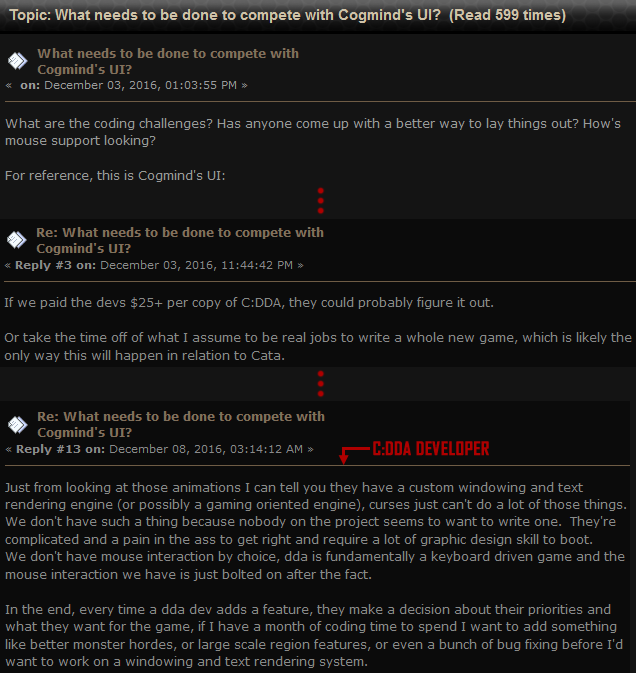
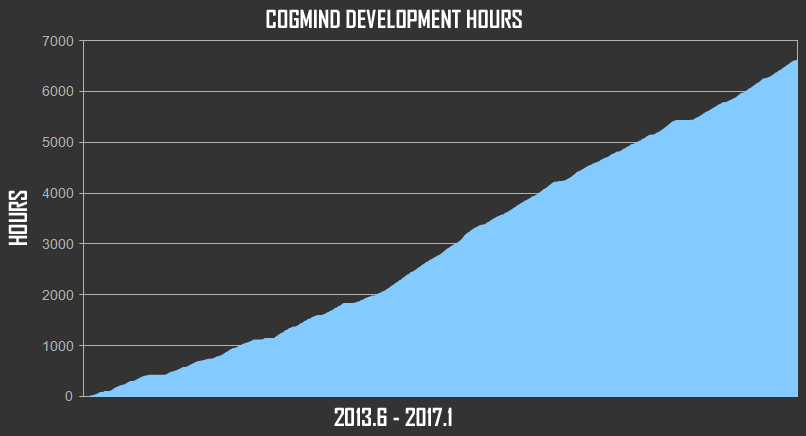

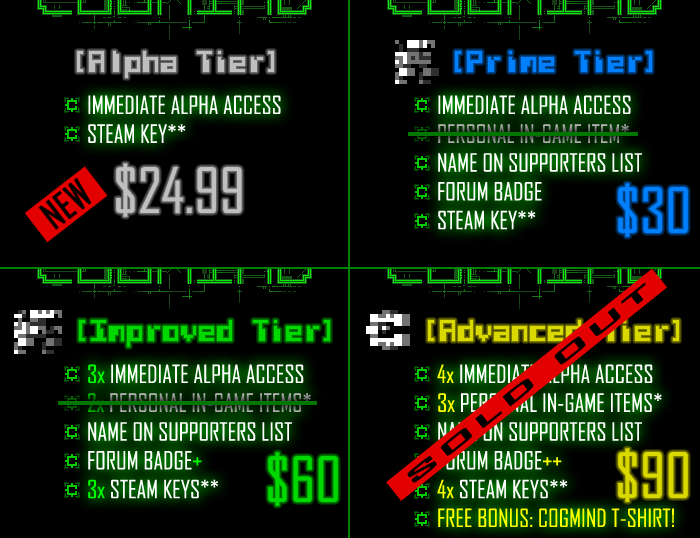




This seems like a rather large amount of effort to explain a really simple concept.
You put effort into something. People want that something, so you should be payed for your work. Balancing what you want and what people are willing to pay for what they want is the key. Often times just finding a median or average between the two will work. (Say people would prefer 15 dollars and you want to sell for 40, you settle on a price of around 27 dollars)
The game seems far too complicated and the visuals too clusterfucky for me at this point (even though I've been following this game for years now I think), so I can't really judge a 30 dollar price as I'm well beyond your target audience from what I can tell.
Yes I can see that you're not the target audience for this article or game :P. It's written for those already steeped in the genre, as well as (more importantly) any other developers looking at tactics for selling a premium niche game in general. Literally no one has done this with roguelikes before, and data points are essential for making the right decisions.
IndieDB isn't really the right outlet for this sort of thing (I debated cross-posting it here at all), as this is an article intended for TIGS, Gamasutra and r/gamedev, but I figured meh why not, some players are quite interested in how a game arrives at its price points, especially considering Cogmind is the second-most expensive roguelike ever (and the most expensive above it did not sell well).
Compare your response to what one developer says: Forums.tigsource.com
"Balancing what you want and what people are willing to pay for what they want is the key. Often times just finding a median or average between the two will work. (Say people would prefer 15 dollars and you want to sell for 40, you settle on a price of around 27 dollars)"
How many games have you sold using this strategy? It doesn't sound like a very effective long-term pricing model considering that it completely ignores the main economic principles referenced in the article. How many people "prefer" $15? Certainly not everyone! In fact, with games, and most specifically traditional roguelikes, I'm pretty confident most people prefer free.
I will buy it to support you.
The love, dedication and hard work you put in your project is an inspiration for me.
Best wishes.
Much appreciated <3
I supposed that as an extension to this topic I should also disclose the fact that I'm aware of a number of people who have bought my game without any real intent to play, but simply as a way to support the ongoing community and developer guidance that I provide. So... some of that revenue is not purely based on the merits of my project alone! :P. Donations are not an option in my country (requires official non-profit status), so this is the only way. (While it's true I accept donations for one of my other freely available dev tools--http://www.gridsagegames.com/rexpaint/--it's such a tiny sum by comparison that it's easy to avoid restrictions.)
Thanks for sharing this info, interesting read. Best of luck to you and your game!
You're very welcome! This and some of my other articles tend to get good responses in general as the kind of detail you rarely see devs talk about. My stated goal from the beginning was to share as much inside information as possible, to the extent that it might assist others in the same way that articles I read years ago helped me.
Developers making the right decisions for the right reasons (and players understanding them :P) is key to an overall healthier indie market!
How mod-able will this game be?
I'm not planning on supporting modding, at least not at first. I may change my mind later, but I'm not sure... lots of factors to consider on the community side, some of which are still unknowns.
In any case, it will unlikely ever be *extremely* moddable, if only because in order to finish it in a reasonable time schedule (you know, like five years :P) I ended up hard-coding a fair number of behaviors, mechanics, and even some data.
There will be lots more options for tweaking the experience, however--in the next version we have challenge modes coming down the pipe: Gridsagegames.com :D